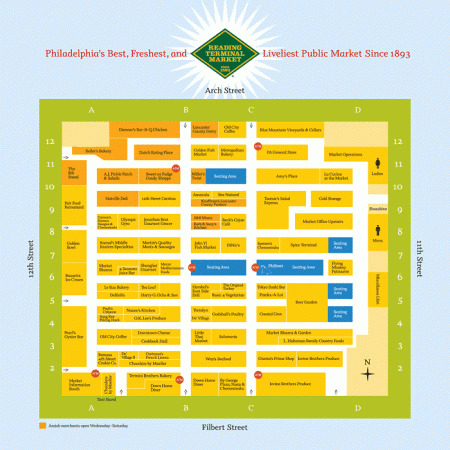Serendip is an independent site partnering with faculty at multiple colleges and universities around the world. Happy exploring!
The Powers of Culture to Disable in Reading Terminal Market

Reading terminal market is a buzzing hotspot for locals and tourists to experience the intra-action of the stirring, culinary melting pot that is Philadelphia. I first traveled here on a date last spring and was pleasantly surprised to discover so many foods and beverages that I like easily and cheaply available. Chicken samosas, mango, banana, and pineapple smoothies, Italian hoagies, Thai fried rice… I could go on! Sitting in the food court, in the heart of the market, amidst the hustle and bustle of the crowds of families, couples, friends, tour groups, band troops, and others is quite an experience.
After reading Culture as Disability, I began thinking about the ways in which spaces of “social interaction” are constructed to create accessibility and/or inaccessibility. I was quick to dismiss the intellectual exercise of thinking about the ways in which these spaces physically create accessibility or inaccessibility, but then realized the mere notion I would consider this a worthless exercise was part of the message of culture as disability that McDermott and Varenne enumerated.
I was in Reading Terminal Market yesterday with my mother, who was visiting me while on business in the area, and found myself observing many ways that the layout and design of the market made itself inaccessible to people with physical disabilities. I’ll flesh some of those thoughts out below, but first want to mention the people I observed who I lumped into this category.
- A man with a broken left foot on crutches
- A woman using a wheelchair
Those of you who have visited RTM know that from 8AM to 6PM it is packed with people. The aisle way between vendors is barely enough space for two people walking in opposite directions to walk past each other without bumping elbows. In the food court, there was hardly enough room for me and my mom to squeeze by the table on either side of us to sit down. During my first visit to the market, the counter where I ordered lunch was so high I had to stand, tip-toe, to grab the bag from the cashier, also obviously standing on tip-toe to complete the hand-off.
These have been my only difficulties while at the market, but I can acknowledge several ways that people with disabilities have more obstacles to just try purchasing and eating a meal or buying groceries.
- The little space between tables in the food court makes it nearly impossible for someone in a wheelchair to be able to sit at a table. The height of the table itself is too low for someone in what I consider to be a standard size wheelchair to sit near. Even the option of sitting at the edge of a table, in the aisle way, is futile. I witnessed a woman in a wheelchair getting nasty looks from people walking by, annoyed that she was taking up space while trying to eat lunch with some friends.
- The hustle and bustle of the market enhances the culture of being on a mission and detesting anyone and everyone that may delay one’s daily routine. With hundreds of people walking along every aisle way, standing in every food vendor line, it’s challenging to maneuver your way around. At Haverford and Bryn Mawr, it seems customary to hold a door for someone or to offer someone the space to walk past in a crowd, especially for those that are on crutches. Unlike our culture in the bi-co, in the market, a man I saw on crutches was not being offered any additional room by people buzzing past him on either side… including a man who bumped into his right crutch without any hesitation. Not one person in the busy aisle way tried to give him additional room.
I found myself being bombarded by all of the ways in which the market was inaccessible to people with physical disabilities. I also started to realize how privileged I am in ways I have never considered before, specifically as an “able-bodied” person. I’ve never even broken a bone and had to experience a cast or crutches. What was a very enjoyable afternoon eating lunch with my mom in RTM began to be, in my mind, the potential for a very frustrating, straining experience of inaccessibility for someone not as able-bodied.
I’m not done thinking about this and I’m not done being surprised or shocked...



